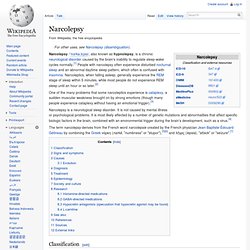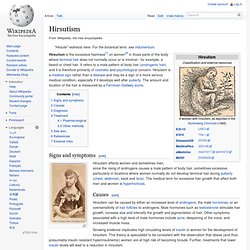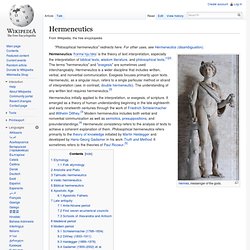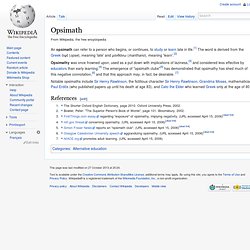

Narcolepsy. Narcolepsy /ˈnɑrkəˌlɛpsi/, also known as hypnolepsy, is a chronic neurological disorder caused by the brain's inability to regulate sleep-wake cycles normally.[1] People with narcolepsy often experience disturbed nocturnal sleep and an abnormal daytime sleep pattern, which often is confused with insomnia.

Narcoleptics, when falling asleep, generally experience the REM stage of sleep within 5 minutes, while most people do not experience REM sleep until an hour or so later.[2] One of the many problems that some narcoleptics experience is cataplexy, a sudden muscular weakness brought on by strong emotions (though many people experience cataplexy without having an emotional trigger).[3] Narcolepsy is a neurological sleep disorder. It is not caused by mental illness or psychological problems. Eschatology. Eschatology.

Qualia. In philosophy, qualia (/ˈkwɑːliə/ or /ˈkweɪliə/; singular form: quale) are what some consider to be individual instances of subjective, conscious experience.

The term "qualia" derives from the Latin neuter plural form (qualia) of the Latin adjective quālis (Latin pronunciation: [ˈkʷaːlɪs]) meaning "of what sort" or "of what kind"). Examples of qualia include the pain of a headache, the taste of wine, or the perceived redness of an evening sky. As qualitative characters of sensation, qualia stand in contrast to "propositional attitudes".[1] Daniel Dennett (b. 1942), American philosopher and cognitive scientist, regards qualia as "an unfamiliar term for something that could not be more familiar to each of us: the ways things seem to us".[2] Erwin Schrödinger (1887–1961), the famous physicist, had this counter-materialist take: Anosognosia. Anosognosia (/æˌnɒsɒɡˈnoʊziə/, /æˌnɒsɒɡˈnoʊʒə/; from Ancient Greek ἀ- a-, "without" , νόσος nosos, "disease" and γνῶσις gnōsis, "knowledge") is viewed as a deficit of self-awareness, a condition in which a person who suffers certain disability seems unaware of the existence of his or her disability.

The word comes from the Greek words nosos, "disease", and gnosis, "knowledge", with an- or a- as a negative prefix. It was first named by the neurologist Joseph Babinski in 1914.[1] Anosognosia results from physiological damage on brain structures, typically to the parietal lobe or a diffuse lesion on the fronto-temporal-parietal area in the right hemisphere.[2][3][4] Whilst this distinguishes the condition from denial, which is a psychological defense mechanism, attempts have been made at a unified explanation.[5] Anosognosia is sometimes accompanied by asomatognosia, a form of neglect in which patients deny ownership of their limbs. Alopecia. Hair loss[1] or baldness (technically known as alopecia[2]) is a loss of hair from the head or body.

Baldness can refer to general hair loss or male pattern baldness specifically. Some types of baldness can be caused by alopecia areata, an autoimmune disorder. The extreme forms of alopecia areata are alopecia totalis, which involves the loss of all head hair, and alopecia universalis, which involves the loss of all hair from the head and the body. Baldness can have many causes, including fungal infection (tinea capitis), traumatic damage, such as by compulsive pulling (trichotillomania), as a result of radiotherapy or chemotherapy, and as a result of nutritional deficiencies such as iron, and as a result of autoimmune phenomena, including alopecia areata and hair loss associated with systemic lupus erythematosus.[3] Terminology[edit]
Hirsutism. "Hirsute" redirects here.

For the botanical term, see indumentum. Hermeneutics. Hermes, messenger of the gods.

Hermeneutics /hɜrməˈnjuːtɪks/ is the theory of text interpretation, especially the interpretation of biblical texts, wisdom literature, and philosophical texts.[1][2] The terms "hermeneutics" and "exegesis" are sometimes used interchangeably. Hermeneutics is a wider discipline that includes written, verbal, and nonverbal communication. Exegesis focuses primarily upon texts. Occasionalism. Occasionalism is a philosophical theory about causation which says that created substances cannot be efficient causes of events.

Instead, all events are taken to be caused directly by God. (A related theory, which has been called "occasional causation", also denies a link of efficient causation between mundane events, but may differ as to the identity of the true cause that replaces them.[1]) The theory states that the illusion of efficient causation between mundane events arises out of God's causing of one event after another. However, there is no necessary connection between the two: it is not that the first event causes God to cause the second event: rather, God first causes one and then causes the other. Islamic theological schools[edit] The doctrine first reached prominence in the Islamic theological schools of Iraq, especially in Basra. Philomath. Opsimath. An opsimath can refer to a person who begins, or continues, to study or learn late in life.[1] The word is derived from the Greek ὀψέ (opse), meaning 'late' and μανθάνω (manthano), meaning 'learn'.[2] Opsimathy was once frowned upon, used as a put down with implications of laziness,[3] and considered less effective by educators than early learning.[4] The emergence of "opsimath clubs"[5] has demonstrated that opsimathy has shed much of this negative connotation,[6] and that this approach may, in fact, be desirable. [7] Jump up ^ The Shorter Oxford English Dictionary, page 2010.

Oxford University Press, 2002.Jump up ^ Bowler, Peter: "The Superior Person's Book of Words", page 101. Polymath. Leonardo da Vinci is regarded as a "Renaissance man" and is one of the most recognizable polymaths.

A polymath (Greek: πολυμαθής, polymathēs, "having learned much")[1] is a person whose expertise spans a significant number of different subject areas; such a person is known to draw on complex bodies of knowledge to solve specific problems. The term was first used in the seventeenth century but the related term, polyhistor, is an ancient term with similar meaning.
The term applies to the gifted people of the Renaissance who sought to develop their abilities in all areas of knowledge as well as in physical development, social accomplishments, and the arts, in contrast to the vast majority of people of that age who were not well educated. This term entered the lexicon during the twentieth century and has now been applied to great thinkers living before and after the Renaissance. A priori (languages) Some a priori languages are designed to be international auxiliary languages that remove what could be considered an unfair learning advantage for native speakers of a source language that would otherwise exist for a posteriori languages. Some a priori languages try to categorize their vocabulary, either to express an underlying philosophy or to make it easier to recognize new vocabulary. These are also known as philosophical or taxonomic languages. Morpheme. Classification of morphemes[edit] Free vs. bound[edit] Every morpheme can be classified as either free or bound.[3] These categories are mutually exclusive, and as such, a given morpheme will belong to exactly one of them.
Bound morphemes can be further classified as derivational or inflectional. Allomorph. In linguistics, an allomorph is a variant form of a morpheme. The concept occurs when a unit of meaning can vary in sound without changing meaning. The term allomorph explains the comprehension of phonological variations for specific morphemes. Allomorphy in English suffixes[edit] English has several morphemes that vary in sound but not in meaning. Examples include the past tense and the plural morphemes. Ideogram. "No Dogs! " sign in Spain.
The dog illustration is a pictogram. The red circle and bar is an ideogram representing the idea of "no" or "not allowed". An ideogram or ideograph (from Greek ἰδέα idéa "idea" + γράφω gráphō "to write") is a graphic symbol that represents an idea or concept. Some ideograms are comprehensible only by familiarity with prior convention; others convey their meaning through pictorial resemblance to a physical object, and thus may also be referred to as pictograms. Terminology[edit] The term "ideogram" is commonly used to describe logograms in writing systems such as Egyptian hieroglyphs, Sumerian cuneiform and Chinese characters. Pasigraphy. Manifold. The surface of the Earth requires (at least) two charts to include every point. Here the globe is decomposed into charts around the North and South Poles. The concept of a manifold is central to many parts of geometry and modern mathematical physics because it allows more complicated structures to be described and understood in terms of the relatively well-understood properties of Euclidean space.
Axiom. Notions. Contingency (philosophy) Phylogenetic tree. In a rooted phylogenetic tree, each node with descendants represents the inferred most recent common ancestor of the descendants, and the edge lengths in some trees may be interpreted as time estimates. Gunk (mereology) In mereology, an area of philosophical logic, the term gunk applies to any whole whose parts all have further proper parts.
Mereology.